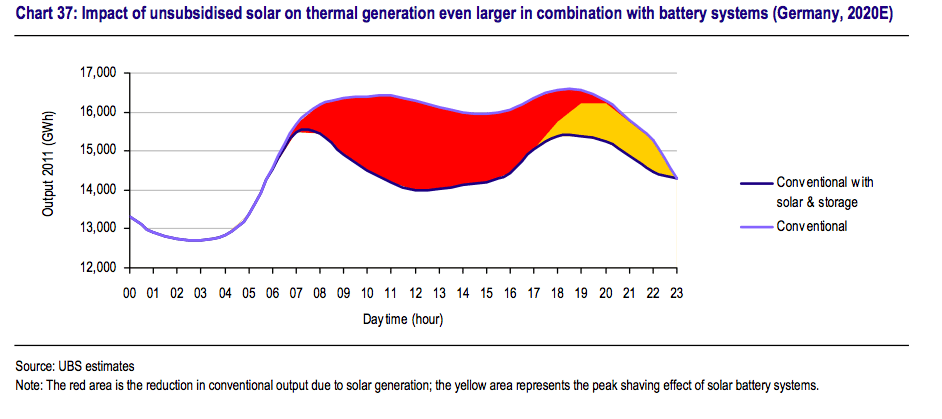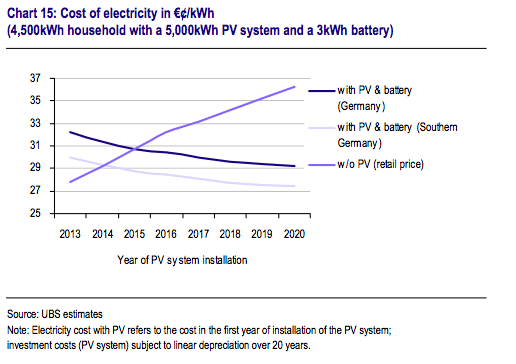| |
 Posted Jan 24, 2013, 5:41 PM
Posted Jan 24, 2013, 5:41 PM
|
|
BANNED
|
|
Join Date: Jun 2005
Location: lodged against an abutment
Posts: 7,556
|
|
Quote:
UBS: Boom in unsubsidised solar PV flags energy revolution
By Giles Parkinson on 23 January 2013
The revolution in energy markets caused by the growing impact of rooftop solar PV is about to take a dramatic leap in scale.
According to analysts from the global investment banking giant UBS, the arrival of socket parity – where the cost of installing solar is cheaper than grid-sourced supplies – is about to cause a boom in un-subsidised solar installation in Europe, and the energy market may never be quite the same again.
Such forecasts have long been the province of environmentalists, climate activists, university researchers, and the occasional industry leader, such as David Crane, the head of NRG, the largest generator of electricity in the US.
Now, the team of energy analysts from UBS, writing in response to plunging power prices in Europe, has issued a stunning report entitled “The unsubsidised solar revolution” – suggesting that investing in solar will become a “no brainer” for households in several European countries, and will have profound implications for the incumbent energy industry.
“Solar has turned from a heavily-subsidised marginal technology into a mainstream source of power generation,” the UBS analysts write. ” “Thanks to significant cost reductions and rising retail tariffs, households and commercial users are set to install solar systems to reduce electricity bills – without any subsidies.”
“We are at the beginning of a new era in power markets,” the UBS analysts write. ”Purely based on economics, we believe almost every family home and every commercial rooftop in Germany, Italy and Spain should be equipped with a solar system by the end of this decade.”
It says up to 18% of electricity demand could be replaced by self-produced solar power in these markets, at the expense of centralised generation. Even as soon as 2020, up to 43GW of unsubsidised solar could be installed in Germany, Italy and Spain, replacing up to 9 per cent of electricity demand. This is on top of reduction in demand caused by energy efficiency measures and weak GDP growth.
The impact on utilities will be profound, and will be made worse by the emergence of cheap battery storage, which would allow households – and businesses – to consumer more of their own energy, and effectively remove the morning and evening peak in pricing, as well as the midday peaks, as we revealed in a dramatic graph in our article last May of Why generators are terrified of solar. Without any peaks, the profit margin of generators is removed. UBS calculates the EBITDA profit pool of the conventional generators will shrink by around 50 per cent.
UBS predicts that by 2020, power prices will fall another 10 per cent, and coal-fired generators, once the major providers of baseload power, will be reduced to the role of filling the gaps between renewable. UBS estimates that the load factor of lignite (brown coal) plants in Germany drops from 72% to 59%, while the load factor of hard coal plants drops from 47% to 31% by 2020. That will give them a lower load factor than many wind or solar farms.
UBS says that the explosion of solar will have a cascading effect – as noted by AGL Energy in Australia, and the local utility in Hawaii. AGL used the circle of death as an argument to reduce feed in tariffs. But the significance of unsubsidised solar is that the proliferation of solar is unstoppable – unless, of course, it is halted by regulation, or fixed tariffs.
|

 http://reneweconomy.com.au/2013/ubs-...volution-60218
http://cleantechnica.com/2013/01/23/...g-ubs-reports/
http://reneweconomy.com.au/2013/ubs-...volution-60218
http://cleantechnica.com/2013/01/23/...g-ubs-reports/
Quote:
Why solar PV without subsidies is a “no-brainer” for households
By Giles Parkinson on 24 January 2013
There was a huge response to our article on Wednesday, summarising the UBS report on how a boom in un-subsidised solar installations would cause a revolution in energy markets. Most people wanted more details of how UBS arrived at their calculations, so we’ve decided to share more of their report on what makes solar PV – and battery storage – such a compelling proposition to households and businesses, even without subsidies.
There are two principal pieces to the equation – the falling cost of solar and battery manufacturing on one side, and the rising cost of grid-based electricity on the other. UBS estimates the total cost of installed solar PV (including inverters and balance of systems costs) has fallen by well over half in the last few years, and will continue to do so, while grid prices (ironically including the cost of renewable subsidies) have risen and will continue to do so.
“In combination, we see this as a game-changer for the competitiveness of solar systems,” the UBS energy team writes. “Private households and commercial users will be able to save on their electricity bills if they install a solar system – without any benefits from subsidies.” As we noted yesterday, just on economics, it said every household in Germany, Italy and Spain should have a solar system by the end of the decade.
UBS says solar PV without subsidies will also be very attractive to commercial groups – particularly stores, supermarkets and offices, but also to most manufacturing enterprises that operate during daytime, because they can consume virtually all of the electricity they produce, and because some could use cheaper ground mounted systems rather than roof mounted modules.
A 130kWp solar PV system could deliver a self consumption rate of around 70 per cent for a German manufacturing company with an electricity consumption of 200MWh per year. A 200kWp system could deliver more solar power, but at the same time more energy would be either wasted or sold back into the grid for little added benefit to justify the extra cost.
“From a managerial point of view, the installation of an unsubsidised PV system is nothing but a one-time investment that leads to a sustainable cost reduction and constitutes a partial hedge against increasing energy prices or general cost inflation over a 20-year period,” UBS notes. “However, an enterprise will only make the investment decision if the expected cost savings exceed the company’s internal required rate of return – ie, the PV installation competes with other investment projects. In this regard, we note that any cost savings that exceed the depreciable investment costs are treated as taxable earnings.”
The consequence of this is the closure of both coal and gas-fired generation. As if on cue, RWE announced on Wednesday that it may mothball some gas fired plants, because they are operating 1,500 hours a year instead of planned 3,000 to 3,500 hours a year, while Jochen Homann, head of federal grid regulator Bundesnetzagentur, predicted a “a string of closure announcements,” of fossil fuel plants because they are now losing money. He said Germany needed “intelligent reform of market design.”
|
 http://reneweconomy.com.au/2013/why-...useholds-49391
http://reneweconomy.com.au/2013/why-...useholds-49391
Quote:
Bloomberg News
European 2014 Coal Falls to Record as UBS Sees Solar Surge
By Marek Strzelecki on January 16, 2013
European coal for 2014 delivery fell to a record as UBS AG said that solar generation’s share of the continent’s electricity use will grow, crowding out production from fossil-fuel plants.
Thermal coal for delivery next year to Amsterdam, Rotterdam or Antwerp declined as much as 0.4 percent to $99.75 a metric ton in London, according to broker data compiled by Bloomberg. That’s the contract’s lowest level since it started trading three years ago.
As much as 18 percent of electricity demand may be met by self-produced solar power in Germany, reducing demand for grid- supplied power by 6 percent to 10 percent by 2020, Per Lekander, a Paris-based analyst at UBS, said in an e-mailed research note.
“Batteries will increasingly shave the evening peak, which further eliminates production hours of thermal plants that used to be attractive,” the analyst said.
German power for delivery in 2014, a European benchmark, fell as much as 1.1 percent to 43.45 euros ($57.61) a megawatt- hour, the lowest level since the start of trading in January 2010.
|
http://www.businessweek.com/news/201...es-solar-surge

|
|
|



